
|
|

December 7, 2007
Medium Trip '07, Part VI: The Des Moines TV/FM Towers
Over the course of 2007, your editor set foot in 20 of our 50 states, visiting broadcast facilities all along the way. And now that the season of travel has ended, it's time to settle back and begin recapping some of what we saw as we criscrossed this land of ours.
This week, we continue our recap of what we'll call "Medium Trip 2007," a 10-day family journey that began and ended in Chicago, taking in much of Iowa and a little of eastern Nebraska along the way, and in the process revisiting for the first time some of the territory from our original Big Trip back in 2001.
When we left off in our last installment, we were heading back into Des Moines after visiting the transmitter site of WHO (1040), one of those heritage Class I-A 50,000-watt nondirectional signals that we enjoy visiting so much. (We made it to a few others this year, too - stay tuned to future episodes of Site of the Week to see WBBM and KSL!)
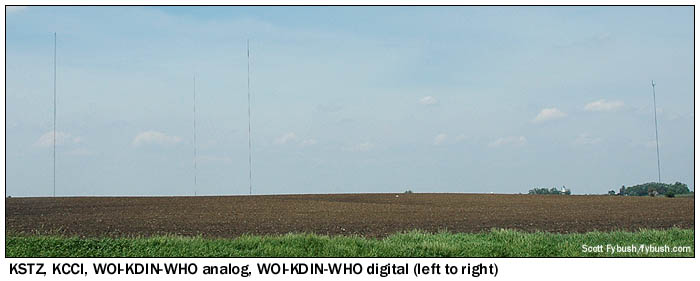
What do we enjoy seeing almost as much as a good 50,000-watt clear channel AM? Something even rarer - a cluster of 2,000-foot TV and FM towers. By their nature, these beasts are seen only in limited parts of the country - air-traffic restrictions and station power limitations keep them out of the crowded northeast, and there's no need for them in the mountain west, where nature has provided much higher vantage points for antennas than mere guyed steel can ever accomplish.
But then there's the big, flat, open terrain of the midwest, where land is readily available, stations are widely spaced, and the stations of Des Moines (to use a handy example) need to cover a 70-mile radius to serve everything that falls within their market.
So it was that we found ourselves, 'round about lunchtime, about a dozen miles north of Des Moines and a couple of miles west of I-35, in the fields surrounding the farm town of Alleman, Iowa, looking way up at the four big towers that form a cluster a little more than a mile from north to south.
Go searching for information about these towers online and you'll find a lot of material put up by fans (mostly Europeans) of tall structures in general, using names like "Hearst-Argyle Tower" or "WOI-Tower" that nobody uses in real life.
From left to right (south to north in the photo above, taken just off exit 96 of I-35), we'll refer to these four as the "KSTZ Tower," the "KCCI Tower," the "Analog Tower" and the "Digital Tower" as we explore their histories. Come along, won't you?
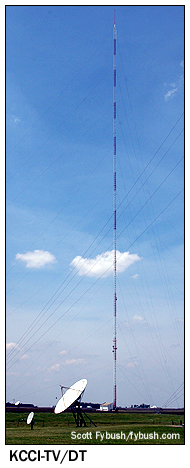
|
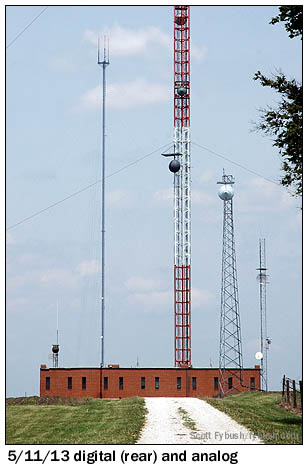
|
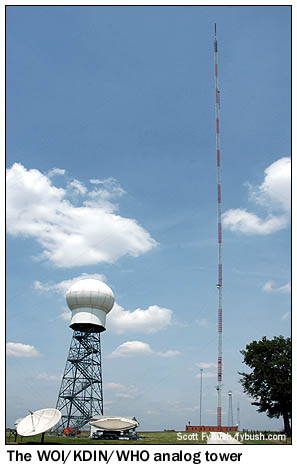
|
It's only in a cluster like this that a 1479-foot tower can look small, but that's the case with the KSTZ tower, which is rather underpopulated for a tall tower these days. This stick went up in 1983, when independent station KCBR (Channel 17) signed on here, reactivating the UHF channel that had been used way back in 1953 by Des Moines' first TV station, the long-defunct KGTV. KCBR changed calls to KDSM a few years after it signed on, becoming a Fox affiliate, and remained on this tower until 2002, when it moved a mile north to the new digital tower, about which we'll say much more in a bit.
 In
the meantime, the tower had acquired a tenant, KRNQ (102.5),
a full class C outlet that was a former sister station to channel
8, the erstwhile KRNT-TV. KRNQ became KSTZ ("Star")
in 1993, and when KDSM vacated the tower in 2002, it sold the
structure to Saga, which by then owned the FM station. And that's
why this very tall tower has nothing whatsoever at its top, and
only a big 14-bay FM antenna on the side for KSTZ.
In
the meantime, the tower had acquired a tenant, KRNQ (102.5),
a full class C outlet that was a former sister station to channel
8, the erstwhile KRNT-TV. KRNQ became KSTZ ("Star")
in 1993, and when KDSM vacated the tower in 2002, it sold the
structure to Saga, which by then owned the FM station. And that's
why this very tall tower has nothing whatsoever at its top, and
only a big 14-bay FM antenna on the side for KSTZ.
Back to channel 8, though: when a consortium of Des Moines' TV stations built the very first tall tower up here in the early seventies, KRNT-TV was the lone holdout. The signal advantage that those stations had over KRNT-TV's 633' tower in downtown Des Moines was immediately apparent, though, and so channel 8 bought land next door to the original tall tower and put up a 1999' tower of its own in 1974. (That same year, the station changed calls to its current KCCI; it eventually moved from its old studio site to a new one a few blocks away, replacing the 633' tower with a new 500' auxiliary tower, still crowned with the weather beacon light that had become a landmark on the original tower.)
Having its own tower proved to be something of a strategic advantage: when digital TV came along, KCCI had plenty of tower space of its own for a new digital antenna, and today the KCCI tower is crowned with a stacked antenna for digital channel 31 and analog channel 8. It will remain on channel 8 after 2009, and presumably the stacked antenna will eventually be replaced with a single-channel antenna for 8. KCCI is now owned by Hearst-Argyle, and that's why some references (we're looking at you, Wikipedia) call this the "Des Moines Hearst-Argyle Television Tower Alleman."
Call it what you will, this tower sits about 1000 feet west of the first tall tower to be built up here in Alleman. In 1972, a consortium made up of NBC affiliate WHO-TV (Channel 13), ABC affiliate WOI-TV (Channel 5) and public broadcaster KDIN (Channel 11) built this 1999-foot tower in an attempt to solve a whole set of signal problems.
WHO-TV was, as we noted in last week's installment, transmitting from the top of the WHO(AM) tower in Mitchellville, 20 miles southeast of Des Moines, which was a fine spot for an AM station but less than ideal for a TV station that needed to reach not only Des Moines but also Ames, 30 miles to the north, not to mention a whole bunch of smaller communities such as Marshalltown, 30 miles east of Ames, and Fort Dodge, 30 miles or so northwest of Ames. (Fort Dodge briefly had a local commercial station of its own, KVFD-TV 21, but it failed and was donated to Iowa Public TV - and my, aren't we digressing now?)
WOI-TV, a commercial station licensed to Ames and operated by Iowa State University, was transmitting from the WOI(AM) tower on the ISU experimental farm south of Ames, which was just fine for viewers in Ames but not at all satisfactory for Des Moines viewers, never mind the big swath of the market that extends 60 miles south from Des Moines to the Missouri border.
And KDIN was on a relatively short self-supporter in downtown Des Moines, which was just fine for Des Moines viewers but not much help for people out of town in any direction.
The Alleman site equalized matters considerably: from 2000 feet in the air at this spot, the stations were able to put city-grade signals (and then some) over Des Moines and Ames, and reception improved considerably in much of central Iowa. The new tower improved FM reception, too: public radio WOI-FM (90.1 Ames) moved here from the AM tower in Ames, while WHO's sister FM station, KLYF (100.3), moved here from the WHO(AM) tower in Mitchellville.
(Oh yeah - the European mast fanatics have a name for this one, too - they call it either the "WOI-Tower" or the "NYT Broadcast Holdings Tower," notwithstanding that WOI was never the sole owner of the tower, and that WHO-TV, which now owns it, is no longer owned by NYT Broadcast Holdings; it - and the tower - now belong to Randy Michaels' Local TV, LLC.)
 |
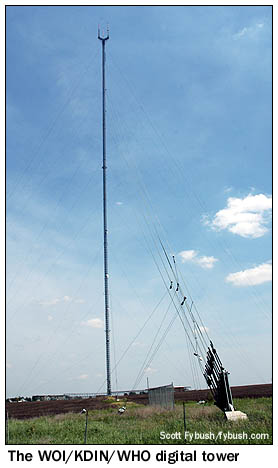 |
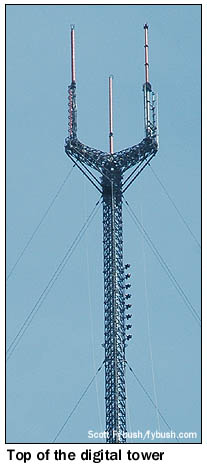 |
The current antenna configuration here looks like this: a combined antenna on the top for channels 11 and 13, with a panel antenna just below for channel 5. A few sections below that is the 10-bay WOI-FM antenna.
So what about all the DTVs, not to mention the other FM, on 100.3? Those all went to the newest, and northernmost, of these towers. At only 1998' (a mere 609.3 meters, compared to the lofty 609.6 meters of the KCCI and WOI/KDIN/WHO analog towers), it's apparently not quite tall enough (or perhaps just too new) to capture the attention of the Europeans, so it doesn't get a fancy name. It's owned by American Towers, and we'll simply call it the "digital tower."
When we were last up this way in 2001, construction on the new tower was just wrapping up. Over the next few years, it would pick up plenty of tenants: the DTV counterparts of the original tower's occupants - WOI-DT (59), KDIN-DT (50) and WHO-DT (19), as well as a new analog station, WB affiliate KPWB (Channel 23, now CW affiliate KCWI) and later a new DTV-only station, My Network affiliate KDMI-DT (Channel 56). In addition, as we noted up top, KDSM (Channel 17) moved its analog signal here in 2002 and put KDSM-DT (Channel 16) on from this site.
There's one radio station here, too: the 100.3 that used to be KLYF is now KDRB, "The Bus," with an 8-bay antenna that gives it 100 kW/1795' and a whomping class C signal all over the region.
What happens here after 2009? We're not quite sure. WOI has to vacate its out-of-core digital channel, as does KDMI - and neither KDMI nor KCWI have paired companion channels. (KDMI-DT broadcasts standard-def digital programming for both KDMI and KCWI right now.) KDIN and WHO are returning to their VHF channels in 2009, and WOI plans to use channel 5 for WOI-DT. It's a good bet that KDIN-DT and WHO-TV will go back to the channel 11/13 antenna on the old "analog tower" - WHO-TV owns the stick, after all. Will WOI-DT return to its channel 5 antenna there, too? KDSM-DT (remaining on 16) and KCWI-DT (flash-cutting on 23) are pretty sure to stay at the new tower, as will KDMI-DT on the channel 31 it's inheriting from KCCI-DT in a negotiated channel election.
In next week's installment, we head north and east to Waterloo, home of another prominent 50 kW AM signal (and some more really tall towers, too.) In the meantime, you guessed it: you can hear legal IDs from WOI-FM, KDRB and plenty of other Des Moines signals as well, next Wednesday at our sister site, Tophour.com.
Tower Site Calendar 2008 is here! Visit the Fybush.com Store now and get your calendar now!
- Previous Site of the Week: The Medium Trip 2007, part V: WHO, Des Moines
- Next Week: The Des Moines TV/FM Tower Farm, Alleman, IA
- Site of the Week INDEX!
- How can you help support Site of the Week? Click here!
- Submit your suggestions for a future Site of the Week!
